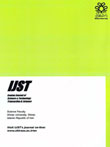فهرست مطالب
Iranian Journal of science and Technology (A: Siences)
No. 2802, 2003
- تاریخ انتشار: 1382/05/15
- تعداد عناوین: 11
-
-
Pages 197-204A simple new closed form of the Green function for axisymmetric magnetostatic problems is found analytically in cylindrical coordinates. The result is verified by applying several examples.Keywords: Magnetostatics, green functions, partial differential equations, electromagnetics
-
Pages 219-226A chaos control method suggested by Erjaee has been reviewed. It has been shown that this technique can be applied in various evolutionary systems of 2-dimensional types. The method has been applied for cases of the Henon map, as well as Burger’s map. The limitations of the control technique have also been discussed by considering the Standard Map and the Gumowski-Mira map. The results obtained through numerical calculations are very interesting and significant. This technique has some advantages over many other techniques of chaos control in discrete systems.Keywords: Asymptotic stability, control parameter, chaos
-
Pages 227-234In this experimental work, by using the method of plasma-chemical etching, we have dealt with the causes of the creation of a distorted layer on the surface of silicon wafers during mechanical machining processes, in addition, the elucidation of connections between the structure of this layer and characteristic parameters of the mechanical strength of these wafers have been studied. Experimental results obtained at room temperature show that after cutting and grinding processes, the mean value of mechanical strength s, which is apparently independent of the types of conductivity, is significantly lower than its theoretical value. Analysis of the dependence of mechanical parameters on the time of plasma-chemical etching indicates that the lower values obtained for the mechanical strength of silicon wafers is basically due to the existence of a distorted layer and corresponding internal stresses created on the surface of these wafers after mechanical machining. Plasma-chemical etching leads to an increase in s value. Dependency of s on the etching time is qualitatively described by the microstructure of the distorted layer and parameters of the micro relief surface of the wafers. Correlation between parameters s, H, K and the microstructure of the distorted layer allows us to suggest the method of plasma chemical etching as a method of investigating the microstructure of the distorted layer after the mechanical machining processes.Keywords: Mechanical properties, silicon wafers, cutting, grinding, etching
-
Pages 235-255
-
Pages 267-275
-
Pages 277-288In the analysis of spatial point patterns, complete spatial randomness (CSR) hypothesis, which is a restriction of a homogenous Poisson process to study region A, operates as a dividing hypothesis between “regular” and “aggregated” patterns. Meanwhile, many alternatives to CSR in aggregated patterns are extensions of homogenous Poisson processes themselves. Therefore, when the CSR hypothesis is rejected, results related to Poisson processes may be used to formulate plausible alternatives to CSR. In this paper, we propose a new statistic for testing CSR and then by applying it in conjunction with a notion of kernels of a point pattern, we determine the “parents” of a Poisson cluster process when the CSR hypothesis is rejected and a Neyman-Scott process is assumed for the point pattern under alternative hypothesis. We have made power studies for our test statistic by simulation, and have also surveyed the performance of our method on a certain point pattern. Finally, the whole method is carried on certain real life data.Keywords: Spatial point patterns, complete spatial randomness, poisson processes, Neyman, Scott processes, cluster analysis
-
Pages 289-298
-
Pages 299-350Analysis of time series data can involve the inversion of large covariance matrices. For the class of ARMA (p, q) processes there are no exact explicit expressions for these inverses, except for the MA (1) process. In practice, the sample covariance matrix can be very large and inversion can be computationally time consuming and so approximate explicit expressions for the inverse are desirable. This paper offers some of these approximations.Keywords: ARMA processes, band matrix, covariance matrix


